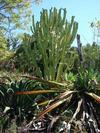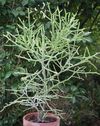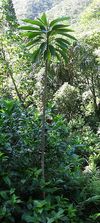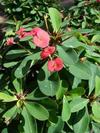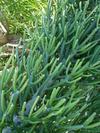Genus Euphorbia
Chamaesyce Esula Euphorbia Rhizanthium and see belowSpecies in the genus Euphorbia of plants
Euphorbia ambovombensis - Euphorbia ambovombensis is a species of plant in the Euphorbiaceae family. It is endemic to Madagascar. Its natural habitats are subtropical or tropical dry forests and subtropical or tropical dry shrubland. It is threatened by habitat loss.
Euphorbia bulbispina - It has been assessed as vulnerable on the IUCN Red List
Euphorbia decaryi - Euphorbia decaryi is a spreading, evergreen plant, under 6" in height, and blooming April-June. Flowers are chartreuse, yellow-green, yellow, or red; female flowers carry a three-part pistil over a three-part ovary, producing three or sometimes more seeds.
Kauai spurge - It inhabits dry, coastal mesic, and mixed mesic forests from 205–670 m . Associated plants include ??hi?a lehua , koa , lama , kukui , ?a?ali?i , wiliwili , hala pepe , ?ohe kukulu?e?o , and ?ulu . Kaua?i Spurge is a small tree, reaching a height of 3–14 metres .
Euphorbia horombensis - Euphorbia horombensis is a species of plant in the Euphorbiaceae family. It is endemic to Madagascar. Its natural habitat is rocky areas. It is threatened by habitat loss.
Euphorbia jamesonii - Euphorbia jamesonii is a species of plant in the Euphorbiaceae family. It is endemic to Ecuador. Its natural habitats are subtropical or tropical moist montanes and subtropical or tropical dry shrubland.
Euphorbia leuconeura - The Madagascar Jewel is grown as a houseplant in some cases. Unlike many succulents, E. leuconeura is less susceptible to overwatering issues. It tends to be relatively easy to care for providing it receives ample sunlight and is free from drafts. When damaged the plant secretes a white fluid which is toxic, causes severe skin irritation and may be a tumor promoting agent. Care should be taken to use gloves when the plant is handled.
Euphorbia mayurnathanii - Euphorbia mayurnathanii is a species of plant in the Euphorbiaceae family. It was endemic to the Palghat Gap in India, but is now believed to be extinct in the wild. It still exists in cultivation, but international trade is controlled as it is included on Appendix II of CITES.
Euphorbia melanocarpa - Euphorbia melanocarpa is a species of plant in the Euphorbiaceae family. It is endemic to Ecuador. Its natural habitat is subtropical or tropical moist montanes.
Crown of thorns - It is a succulent climbing shrub growing to 1.8m tall, with densely spiny stems, the straight, slender spines up to 3 cm long, which help it scramble over other plants. The leaves are found mainly on new growth,
Euphorbia namuskluftensis - The fruits of euphorbias are hard, woody capsules, made up of three segments, each containing a relatively large seed. When the capsule ripens, it explodes and scatters the seeds over amazing distances. As euphorbia seeds have a limited shelf-life, they are rarely offered commercially.
Euphorbia pachypodioides - This small plant is available from several sources for enthusiasts. It is attractive, but slow growing.
Euphorbia quitensis - Euphorbia quitensis is a species of plant in the Euphorbiaceae family. It is endemic to Ecuador. Its natural habitat is subtropical or tropical moist montanes.
Indiantree spurge - It has a wide distribution in Africa, being prominently present in northeastern, central and southern Africa. It may also be native in other parts of the continent as well as some surrounding islands and the Arabian peninsula and has been introduced to many other tropical regions. Its status in India is uncertain. It grows in dry areas, and is often used to feed cattle or as hedging. in Sinhalese.





